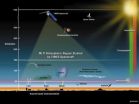Infants' hemodynamic responses to happy and angry facial expressions
Neuroscientific study using near-infrared spectroscopy
2010-11-06
(Press-News.org) Japanese research group led by Prof. Ryusuke Kakigi and Dr. Emi Nakato (National Institute for Physiological Sciences: NIPS) and Prof. Masami K Yamaguchi (Chuo University) found that the hemispheric differences in the temporal area overlying superior temporal sulcus (STS) when processing positive (happy) and negative (angry) facial expressions in infants. Their finding was reported in NeuroImage.
Near infrared spectroscopy (NIRS) is an optical imaging technique that can measure changes in the concentrations of oxyhemoglobin (oxy-Hb), deoxyhemoglobin (deoxy-Hb), and total hemoglobin (total-Hb) as an index of neural activation. Recently, NIRS has been widely used to reveal the brain activity for cognitive processing in awake infants.
Neuroimaging studies in adults has revealed that the STS is involved in the processing of facial expressions, while infants' brain regions involved in perceiving facial expressions has not been investigated. To examine whether the STS is responsible for the perception of facial expressions in infants, the research group measured the hemodynamic responses in STS during the perceptions of happy and angry faces with NIRS.
The findings showed that 1) the hemodynamic responses elicited by the perception of happy faces increased continuously even after the happy face stimuli disappeared, whereas of the neural response to angry faces decreased much more rapidly when the presentation of angry faces ceased, and that 2) the left temporal area of infants' brain was significantly activated for happy faces, while the right temporal area was activated for angry faces.
The research group said, "the different hemodynamic responses between the perception of positive and negative expressions in infants is related to the different biological meanings of positive and negative facial expressions; a positive facial expression can convey a pleasant meaning, while a negative facial expression can be unpleasant or convey danger. The hemispheric lateralization of neural responses to facial expressions develops by the age of 6 months."
INFORMATION: END
ELSE PRESS RELEASES FROM THIS DATE:
2010-11-06
Most mutations in the genes of the Salmonella bacterium have a surprisingly small negative impact on bacterial fitness. And this is the case regardless whether they lead to changes in the bacterial proteins or not. This is shown by Uppsala University scientists in an article being published today in the prestigious journal Science.
The researchers have examined the impact of mutations on the rate of growth of the Salmonella bacterium and show that most mutations have generally very small effects. Moreover the negative effects are of the similar magnitude for changes that ...
2010-11-06
From apocalyptic forecasting to estimates of mass extinctions, climate change is a topic which is filled with fearful predictions for the future. In his latest research, published in WIREs Climate Change, historian Matthias Dörries examines the cultural significance of fear and how it became a central presence in current debates over climate change.
Climatic change, as represented by the media, often prompts headlines predicting disastrous events, frequently adopting fear laden language including analogies with war and warnings of the imminence or irreversibility of ...
2010-11-06
Toronto, Ontario, November 5, 2010 – Even though most adults want to avoid looking older than their actual age, research led by St. Michael's Hospital shows that looking older does not necessarily point to poor health. The study found that a person needed to look at least 10 years older than their actual age before assumptions about their health could be made.
"Few people are aware that when physicians describe their patients to other physicians, they often include an assessment of whether the patient looks older than his or her actual age," says Dr. Stephen Hwang, a ...
2010-11-06
Evolutionary divergence of humans from chimpanzees likely occurred some 8 million years ago rather than the 5 million year estimate widely accepted by scientists, a new statistical model suggests.
The revised estimate of when the human species parted ways from its closest primate relatives should enable scientists to better interpret the history of human evolution, said Robert D. Martin, curator of biological anthropology at the Field Museum, and a co-author of the new study appearing in the journal Systematic Biology. Here is a link to the article: http://sysbio.oxfordjournals.org/content/early/2010/11/04/sysbio.syq054.full.html?ijkey=CaQif1LgTAd7xOD&keytype=ref
Working ...
2010-11-06
HOUSTON -- (Nov. 5, 2010) -- A new study by Rice University bioengineers finds that the workhorse proteins that move cargo inside living cells behave like prima donnas. The protein, called kinesin, is a two-legged molecular machine. Rice's scientists invented tools that could measure the pulling power of kinesin both singly and in pairs, and they report this week in Biophysical Journal that kinesins don't work well together -- in part because they are so effective on their own.
"Researchers have been investigating the mechanical properties of individual motor proteins ...
2010-11-06
VEHICLES -- Charge on the fly . . .
A prototype charging system for electric and hybrid vehicles is helping demonstrate a technology that could one day play a key role in the electrification of America's highways. The bench-scale prototype developed at Oak Ridge National Laboratory is allowing researchers to quantify the power transfer parameters necessary to wirelessly charge stationary and moving vehicles. "Our laboratory tests have been successful in transmitting greater than 4 kilowatts," said Laura Marlino of the Energy and Transportation Science Division. "This ...
2010-11-06
Tomas strengthened to hurricane status and is currently lashing Hispaniola and eastern Cuba today and the GOES-13 satellite provided a visible image of its extensive cloud cover.
The Geostationary Operational Environmental Satellite known as GOES-13 captured a visible image of Hurricane Tomas on Nov. 5 at 1331 UTC (9:31 a.m. EDT) centered over the southwestern tip of Haiti. In the image the clouds to the north of Tomas are associated with a cold front off the eastern U.S. coast. GOES satellites are operated by NOAA. The NASA GOES Project at NASA's Goddard Space Flight ...
2010-11-06
Nine years after beginning its unprecedented look at the gateway between Earth's environment and space, not to mention collecting more data on the upper atmosphere than any other satellite, NASA's Thermosphere Ionosphere Mesosphere Energetics and Dynamics (TIMED) mission has been extended again.
Before the launch of TIMED, the mesosphere and lower thermosphere/ionosphere -- which help protect us from harmful solar radiation -- had been one of the least explored and understood regions of our environment.
"The middle part of the atmosphere was the part we kind of ignored," ...
2010-11-06
United States and Japanese researchers have identified a key step in metabolic pathways linked to diabetes and cancer. The study on activation of the protein complex TORC 2 was published online in the journal Current Biology Oct. 28.
TORC 2 activates a protein called Akt, which plays a crucial role in how cells respond to insulin, said Kazuo Shiozaki, professor of microbiology in the College of Biological Sciences at UC Davis and senior author on the paper.
Normally, insulin triggers fat and muscle cells to take up sugar from the blood. Patients with type II diabetes ...
2010-11-06
By tracking the flow of information in a cell preparing to split, Johns Hopkins scientists have identified a protein mechanism that coordinates and regulates the dynamics of shape change necessary for division of a single cell into two daughter cells.
The protein, called 14-3-3, sits at an intersection where it integrates converging signals from within the cell and cues cell shape change and, ultimately, the splitting that allows for normal and abnormal cell growth, such as in tumors.
In a report published Nov. 9 in Current Biology, the Hopkins team links 14-3-3 directly ...
LAST 30 PRESS RELEASES:
[Press-News.org] Infants' hemodynamic responses to happy and angry facial expressions
Neuroscientific study using near-infrared spectroscopy


